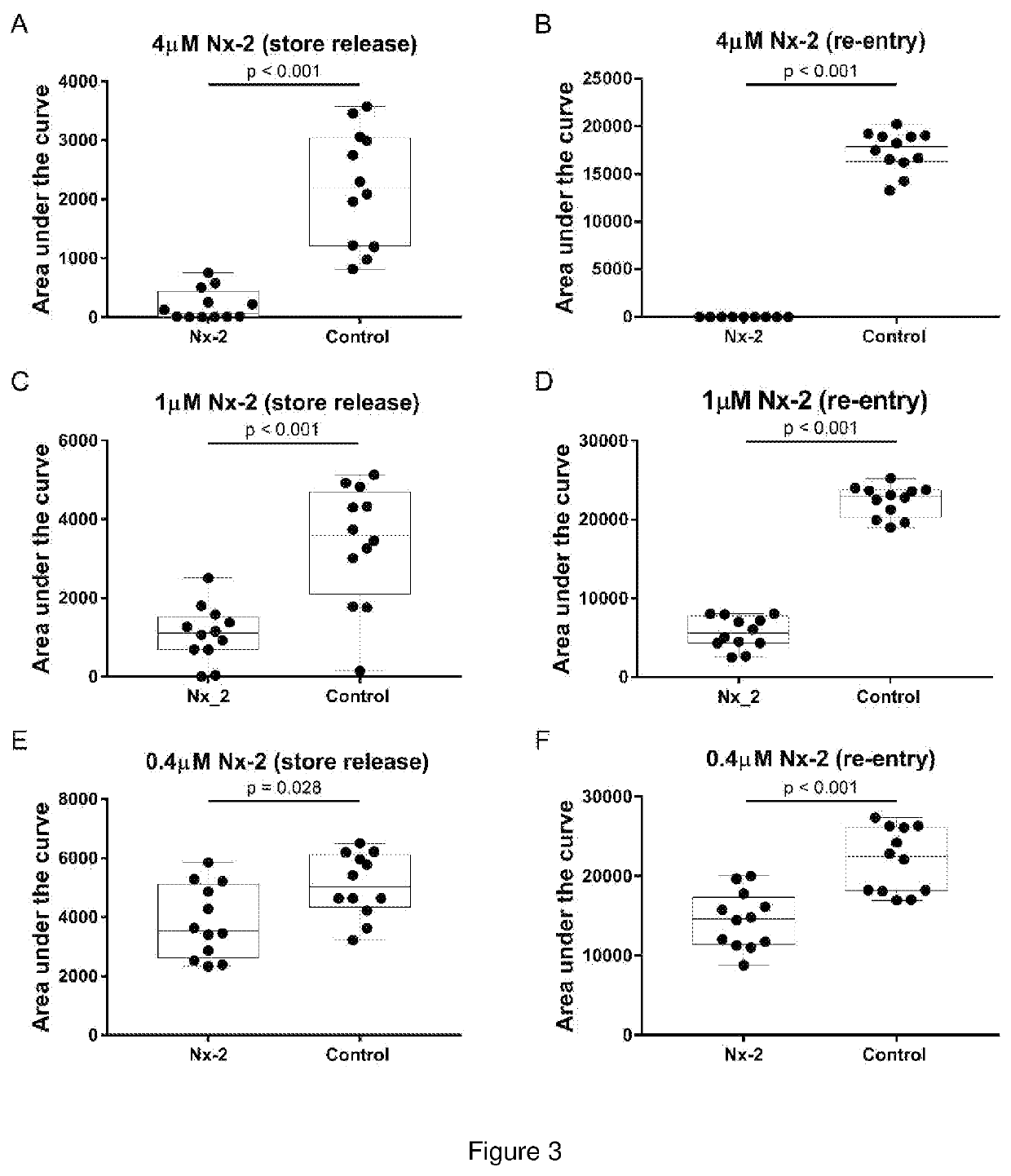Treatment of excitotoxicity
a technology of excitotoxicity and treatment methods, applied in the direction of organic active ingredients, nervous disorders, suppositories delivery, etc., can solve the problems that the therapeutic opportunities of the compound have not been translated into the clinic, and achieve the effects of inhibiting ca2+ uptake, inhibiting ca2+ release, and inhibiting ca2+ releas
- Summary
- Abstract
- Description
- Claims
- Application Information
AI Technical Summary
Benefits of technology
Problems solved by technology
Method used
Image
Examples
example 1
In Vitro Block of Ca2+ entry in rHEK293-GCaMPg cells with Nx-1 and Nx-2
[0185]Aim
[0186]To determine the capacity of Compound 1 to inhibit intracellular Ca2+ store release and / or Ca2+ entry (Ca2+ mobilisation).
[0187]Methods
[0188]Untransfected human embryonic kidney 293 (HEK293) cells are a model for neuronal cell Ca2+ signalling via Gq type G protein-coupled receptors (such as the metabotropic glutamate receptors). These cells exhibit robust G protein (Gq) coupled activation of phospholipase C—inositol trisphosphate (IP3) production [Jiefei T et al., 1999 Biochemical Journal, 343, 39-44], where inositol trisphosphate (IP3) activates the IP3 receptors, which are ion channels that allow Ca2+ to exit into the cytoplasm from the endoplasmic reticulum. The current study utilised a custom-developed recombinant human embryonic kidney 293 (rHEK293) cell line stably over-expressing a genetically encoded Ca2+ reporter (GCaMP5g—after [Akerboom J et al., 2012 Journal of Neuroscience, 32(40): 1381...
example 2
In Vivo Model of Block of Ca2+ Mobilisation by Compound 1
[0201]Aim
[0202]To determine the capacity of Compound 1 to mitigate neuronal injury by blocking of Ca2+ mobilisation associated with brain ischemia in vivo.
[0203]Methods
[0204]All in vivo experiments were performed with University of New South Wales (UNSW) Sydney Animal Care and Ethics Committee approval. To undertake this randomized blinded photothrombotic study, male and female mice (C57BI / 6J) aged 2-4 months (20-30 g) were anaesthetised with a 4% isoflurane induction (on O2) and fixed onto a stereotaxic frame. Anaesthesia was maintained at 1.5% isoflurane for the rest of the procedure. The animals were constantly monitored for their heart rate and oxygen saturation with their body temperature maintained at 37±1° C. (Kent Scientific Physiology Suite system). An ophthalmological ointment was applied to the eyes for corneal protection. Analgesia Temgesic (Buprenorphine; 0.15 mg / kg; 0.32 mg / ml) was administered intramuscularly, u...
example 3
In Vivo Model of Block of Ca2+ Entry by Nx-1
[0210]Aim
[0211]To determine the capacity of Nx-1 to mitigate neuronal injury by blocking of Ca2+ mobilisation associated with brain ischemia in vivo.
[0212]Methods
[0213]The skull of the mouse (C57BI / 6J strain) was exposed to enable fibre optic illumination of a region of the cerebral cortex with green light (532 nm) to trigger localized thrombus formation due to tail vein injection of the photo sensitizing dye Rose Bengal. Macroscopic representation of the photo-thrombotic infarct was assessed 5 days post injury in mice treated with carrier only or with Nx-1 drug. Representative median darkfield images of the coronal brain slice (50 μm thick) from mice treated with carrier only or Nx-1 drug where taken and damaged tissue was assessed.
[0214]Results
[0215]The box plot shows the 25th and 75th percentile boundaries with the error bars indicating the 95% percentile is shown in FIG. 7. The individual data points of the infarct volumes were overlai...
PUM
| Property | Measurement | Unit |
|---|---|---|
| particle size | aaaaa | aaaaa |
| particle size | aaaaa | aaaaa |
| size | aaaaa | aaaaa |
Abstract
Description
Claims
Application Information
 Login to View More
Login to View More - R&D
- Intellectual Property
- Life Sciences
- Materials
- Tech Scout
- Unparalleled Data Quality
- Higher Quality Content
- 60% Fewer Hallucinations
Browse by: Latest US Patents, China's latest patents, Technical Efficacy Thesaurus, Application Domain, Technology Topic, Popular Technical Reports.
© 2025 PatSnap. All rights reserved.Legal|Privacy policy|Modern Slavery Act Transparency Statement|Sitemap|About US| Contact US: help@patsnap.com



